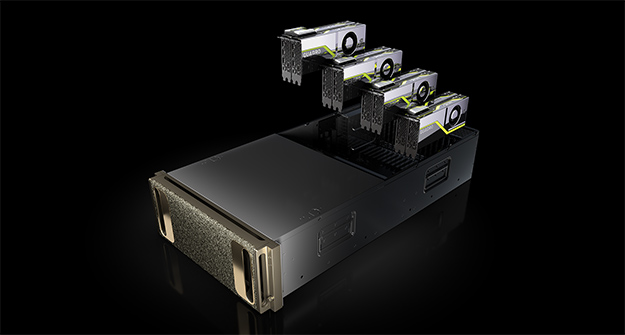Shaping up to be the biggest leap since the CUDA GPU back in 2006, Turing fuses real-time ray tracing, simulation, AI and rasterisation to fundamentally change how we look at computer graphics.
Featuring RT Cores to accelerate ray tracing, and Tensor Cores for AI inferencing, Turing pairs them together for the first time, making real-time ray tracing a reality. Turing changes the way content is created and enjoyed across a wide variety of industries, opening truly amazing creative possibilities today that were thought to be years away.

RT Cores for Real-Time Ray Tracing
Armed with dedicated ray-tracing processors, named RT Cores, the computation of how light and sound travel in 3D environments is accelerated to up to 10 Giga Rays per second. Turing accelerates real-time ray tracing by 25x over the previous Pascal generation, and can be used for final frame rendering for film effects at more than 30x the speed of CPUs.
Tensor Cores for AI Acceleration
Providing up to 500 trillion Tensor operations per second, deep learning training and inferencing is accelerated by these Tensor Cores. This level of performance dramatically accelerates AI enhanced features such as denoising, resolution scaling and video re-timing.
New Streaming Multiprocessor
Raster performance over the previous Pascal generation is dramatically improved by the Turing architecture with an enhanced graphics pipeline and new programmable shading technologies. These technologies include variable-rate shading, texture-space shading, and multi-view rendering. All of this means improved VR experiences, and more fluid interactivity with large models and scenes.
CUDA for Simulation
Turing-based GPUs feature a new streaming multiprocessor (SM) architecture that supports up to 16 trillion floating point operations per second. Up to 4,608 CUDA cores with NVIDIA’s CUDA 10, FleX and PhysX SDKs mean developers can create complex simulations such as particles or fluid dynamics for scientific visualisation, virtual environments and special effects.
Currently, there is only speculation as to a release date. For now, the NVIDIA Quadro P4000, P5000 and P6000 are available at CAD Software Direct.
NVIDIA RTX Server
NVIDIA has enhanced its RTX development platform with new AI, ray tracing and simulation SDKs, to take full advantage of Turing’s capabilities. The result? Incredible designs, highly realistic simulations and stunning visual effects —faster than ever before. The NVIDIA RTX Server defines a new standard for on-demand rendering in the datacenter, enabling easy configuration of on-demand render nodes for batch and interactive rendering. It combines Quadro RTX GPUs with new Quadro Infinity software to deliver a powerful and flexible architecture to meet the demands of creative professionals. With industry leading content creation and render software pre-installed, the NVIDIA RTX Server provides a powerful and easy-to-deploy rendering solution that can scale from small installations to the largest data centers, at one quarter of the cost of CPU-only render farms.
NVIDIA Turing Optimised SDKs
NVIDIA RTX Platform
With NVIDIA Turing GPU architecture at its foundation, the NVIDIA RTX development platform fuses ray tracing, deep learning, simulation, and advanced shading to fundamentally transform the creative process. Now, designers and artists can create amazing content in a completely new way with real-time, photorealistic rendering and AI-enhanced graphics, video, and image processing.
NVIDIA NGX SDK
NVIDIA NGX is a new deep learning-based technology stack bringing AI-based features that accelerate and enhance graphics, photos imaging and video processing directly into applications. The NGX SDK provides pre-trained networks, making it easy for developers to integrate AI features.
GameWorks Ray Tracing SDK
The GameWorks Ray Tracing SDK enables ray-traced area shadows, ray-traced glossy reflections and ray-traced ambient occlusion. As part of the RTX platform, developers can create realistic, high-quality reflections that capture the scene around it and achieve physically accurate lighting and shadows.
Material Definition Language
The NVIDIA Material Definition Language (MDL) gives creatives the freedom to share physically based materials and lights between applications. Currently supported by applications including Allegorithmic Substance Designer, Chaos Group’s V-Ray, and the newly release Epic Unreal Studio 4.20, MDL SDK is now open source allowing for tighter application integrations.
Deep Learning SDK
CUDA 10 – Turing-optimized CUDA 10 includes performance optimized libraries, new programming model constructs for defining program execution, and enhanced graphics API interoperability. CUDA 10 will be releasing soon for use with Turing GPUs.
cuDNN 7.2.1 – The backbone for GPU accelerated frameworks, cuDNN 7.2 now features Tensor Core acceleration with FP32 inputs and outputs and more RNN use cases, including cell clipping and padding masks. Turing support coming soon.


